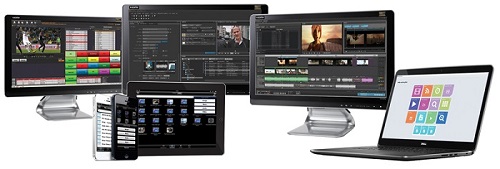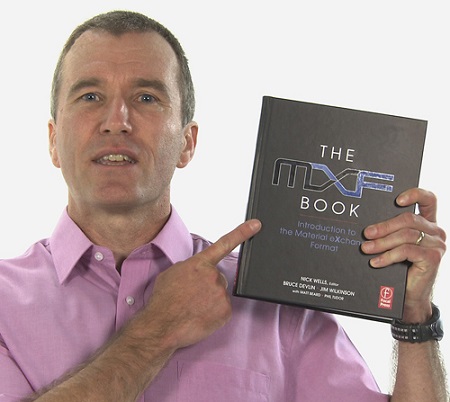Mastering the Workload: Q&A With Dalet's Bruce Devlin
ALEXANDRIA, VA.—Running a TV station is complicated, and one way to tame the wild broadcast beast is to automate wherever possible. However, various functions at a broadcast station can have different needs and require different management/automation solutions—what is the right way to get the broadcasting machine working as cooperatively as possible?
Bruce Devlin, chief media scientist for Dalet, has been working in the broadcast industry since 1986. He joined the BBC Research Department working on Radio Camera systems before moving to France, where he worked on sub-band and MPEG coding for Thomson. He joined Snell & Wilcox in 1993, where he started the company's work on compression coding.
Devlin was then the chief technology officer at AmberFin, the software company that makes iCR—an ingest and software transcoding engine. Bruce holds several patents in the field of compression, has written international standards and contributed to books on MPEG and file formats. He is co-author of the MXF file format specification and an active contributor to the work of SMPTE and the Advanced Media Workflow Association.

Dalet Galaxy multitools multiplatformBE Extra talked with Bruce about automation in an all-IT world.
BE Extra: Three decades ago, TV station automation was overwhelmingly proprietary and expensive. Today, automation is primarily software that runs on standard computers, and it is affordable enough that every broadcaster can have it. What was it like riding that technology wave?
Devlin: The journey may have been lumpy, but the results speak for themselves. Looking back on those early days, it was not just the hardware that was proprietary, but also the protocols. Once your automation had good coverage of the different device protocols, you could start concentrating on user experience and business efficiency. After all, the technology is there to deliver these things to the end customer. Standard software on standard platforms with standard interfaces reduces unnecessary cost and enables us to focus on customer needs.
BE Extra: One of the trends in automation is to combine nearly all of a broadcaster's functions into it, including sales, traffic, ingest/playout, programming, maintenance/engineering, scheduling and other operations. Is that putting too many eggs in one basket?
Get the TV Tech Newsletter
The professional video industry's #1 source for news, trends and product and tech information. Sign up below.
Devlin: I'm not sure how widespread that trend is. We certainly see zoning of automation and media asset management systems with the desire for clear interfaces at the boundaries. The user needs from a newsroom control system and from a production MAM are quite different. Even if the same vendor fulfills both requirements in a facility, there are usually business and geographic interfaces between the systems to manage operational, business and technical risks. At the end of the day, it's a business decision whether a multi-vendor integration is less risky than single-vendor integration. Getting multiple vendors to work together is nearly always more difficult and costly in the short term. The question to be answered on each occasion is, "Does that cost, in reality, reduce my long term risk?" The answer changes case by case.
BE Extra: What are one or two automation features that broadcasters should ask about that somehow get overlooked? Why are they important?
Devlin: First and foremost, consistency of user experience. It's often forgotten that even in an automated system, it's the humans that can make or break a system. Second is openness. Even in single-vendor solutions, the changing demands of the industry and consumers often mean reacting quickly to new trends and requirements, which is much easier to do with open standards and protocols.
BE Extra: A few years ago, the "channel-in-a-box" was all the rage in the industry. Has the market cooled for that, or is it still a viable product?
Devlin: I think channel-in-a-box was key for a while because it was an obvious cost-saving method to be made in the broadcast chain at the time. Popularity of the solutions came from well-crafted interfaces and flexible software adding value to generic IT-based hardware. The broadcast chain has changed in a way that has de-emphasized the importance of traditional play-out devices, and I believe that today's big cost saving is to untangle workflow, increasing the reliability, consistency and quality of the media, file or stream delivered to the consumer. Joined-up MAM is key to this.

Devlin was the co-author of "The MXF Book."BE Extra: Some broadcasters are consolidating their stations into regions, and they are using master control from a single point for multiple stations. What should they plan for from an automation standpoint when considering such a move?
Devlin: Managing the media as a distributed pool of shared content is key to making the required savings. Multi-site working with content ubiquity, management, sharing and replication is fundamental to achieving the required cost savings.
BE Extra: Is there anything else that broadcasters need to know regarding the operation and maintenance of automation systems? Any thoughts on the future of automation?
Devlin: One key to getting great benefits from automation is to think about the automation system as the brain for a specific portion of the end-to-end supply chain management. For example, a facility that manages hundreds of different media types will require more business rules and more interventions than one that has fewer than 10 media types. When looking at the big picture, savings can be made by having good "normalization"—interfaces at the edge of a facility where the number of media formats is reduced to the minimum number for successful operation. Within the facility, working with metadata rather than proliferating more versions is always more efficient. Finally rendering the required versions against strict delivery specifications keeps processes automated and slick. This requires good coupling between MAM, ingest, transcode, QC, the delivery specifications and human workflows.
Bob Kovacs is the former Technology Editor for TV Tech and editor of Government Video. He is a long-time video engineer and writer, who now works as a video producer for a government agency. In 2020, Kovacs won several awards as the editor and co-producer of the short film "Rendezvous."

